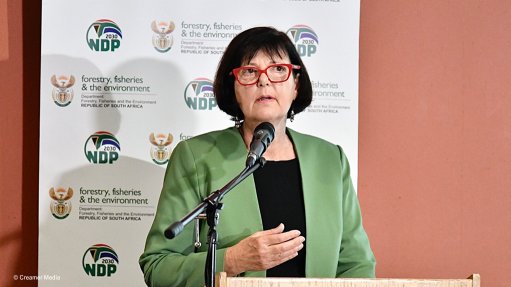OMRON explains how to achieve sustainable manufacturing
This article has been supplied as a media statement and is not written by Creamer Media. It may be available only for a limited time on this website.
Sustainability in the packaging industry is one of the key aspects of fighting the plastic waste issue and ultimately climate change. The challenges that this presents, require flexible and powerful automation technology.
In times of increasing sustainability efforts, it is essential to find ways to develop more environmentally friendly packaging, conserve resources, and rely on smart and more efficient production lines.
Holistic concepts are needed. Take coffee capsules, for example: On the one hand, consumers want a quick and easy way to prepare a fresh cup of coffee in the morning. On the other hand, the popular disposable capsules represent a huge environmental burden. A more environmentally conscious consumer demands the coffee beans be grown more sustainably and fairly, the capsules to be produced in a more environmentally friendly way, and their recycling to become greener. New sustainable manufacturing approaches are the key.
Pillars of sustainable packaging
Key points to consider for more sustainable packaging: First thing to address is, reducing packaging material – not only in terms of virgin plastics content in primary packaging but also in the amount of protective secondary and final packaging. Another point to work on is to eliminate the need for single-use packaging. Some strategies to tackle this issue start with increasing the use and scaling of reusable and refillable systems, redesigning the package with alternative packaging materials that facilitate recycling, are biodegradable, compostable, or have a lower impact on the environment if they end up in the landfill. Packaging made from mono materials is another strategy attracting increasing interest in the packaging industry. They have better recyclability but migrating to them could be a challenging process that requires strict process control as many times, packaging equipment needs to be adapted or customized to achieve an advanced form, fill and seal process that ensures the same package quality and performance.
New requirements for production facilities
Looking at one of the strategies for more sustainability in the packaging industry is reducing the amount of plastic, especially if it's virgin. A key tactic to do it is shifting from rigid to flexible packaging. Thinner walls, smaller sizes, narrower seams, and lighter weights are good ways to reduce the amount of virgin plastic used in the primary container. Added to this is the use of nanomaterials already mentioned, paper-based and biopolymers, as well as an increase in the proportion of recycled material in main packaging, protective and transport packaging (primary, secondary and final packaging).
Switch to new materials, ensure quality and safety
If more sustainable materials are used in packaging, it is still of the highest importance to ensure the quality of the product. At the manufacturing line changing to more sustainable materials means avoiding typical problems in the primary package like material jams or tears, poor quality seals, or incorrect labelling.
For example, paper-based materials have a different tear and puncture resistance, which implies a more precise control in package forming, shrink film made from recycled plastic has very different shrink properties compared to films made from virgin materials, demanding versatile but accurate shrinking temperature control.
What is needed is future-proof manufacturing with automation and robotics technology that can work flexibly with different materials. The following examples show what companies should specifically look for:
1. Challenge film jamming
Thinner, recycled films are more sustainable, but can also tangle more quickly. Correct handling with maximum throughput and minimum film consumption is key to overall OEE (Original Equipment Effectiveness). Therefore, if creases are forming in the seal, operators should check for machine errors that are contributing to the film not being fed correctly.
Examples include misaligned rollers, different feeding devices, or stuck rollers that do not rotate freely. OMRON‘s Film Tension Control System provides synchronized control of tension, feed, and cut. This is complemented by (colour) mark detection for film compensation through motion control to ensure optimal unwinding of the roll. The OMROM Packaging Library offers a wide range of function blocks for film processing in VFFS machines.
2. Challenge film sealing
Thinner film materials offer lower costs and improved aesthetics. However, these materials are more sensitive to heat and susceptible to burning through when using traditional adhesives and sealing technologies. The actual sealing temperature must therefore be constantly and precisely controlled and automatically adjusted to avoid losing productivity or sealing defects that will generate rejects and waste. OMRON addresses this challenge with an AI-based temperature control algorithm synchronized with machine movement and sensor technology that can be placed closer to the sealing bar. Noise is compensated for by an automatic filter adjustment function.
3. Challenge quality control of packaging and label
Re-closable packaging or pouches with nozzles are increasingly replacing rigid plastic containers. Flexible packaging with new elements such as resealable closures places different demands on packaging integrity and quality testing. Thinner films, bio-based materials, or those with a higher recycled content have a different thermal, elongation, and puncture resistance profile. More sustainable materials such as non-laminated or nanomaterials also change shape and can reduce the fidelity or performance of label printing. Reading, checking, or verifying label information on packaging is difficult when the shape is inconsistent, or the print quality changes. OMRON addresses this with its High-Speed Inspection System: this simple and scalable system is suitable for multiple lines and transparent integration with robotic systems. It offers a multi-camera platform with a single controller for multiple-image capture at high speed to reliably detect potential defects. Advanced algorithms help to detect difficult-to-read characters, in variable light conditions and high speeds.
4. Challenge new adhesives and gluing techniques
Eliminating tapes and minimizing adhesives increases the recyclability of cartons. Removing the need for a silicone strip makes it 100% recyclable and biodegradable. To produce and seal cartons, companies are increasingly relying on a strategic and reduced application of adhesives. This requires a high level of precision and continuous quality control. With its automated visual inspection system, OMRON supports the accurate detection of glue patterns. The high resolution and brightness settings allow low-contrast defects to be detected, even in the toughest light conditions or with difficult-to-detect materials.
5. Challenge of multi-material handling
Cardboard boxes made of recycled fibres have higher porosity and are more flexible. Using traditional machines or unpacking and repacking manually, handling boxes made of recycled cardboard without damaging them can be tricky. It is advisable to have an integrated collaborative robot (cobot) solution with dedicated grippers to safely handle a wide range of irregular shapes, porosity levels, and delicate objects.
OMRON offers a complete solution for sustainable packaging line automation that helps companies become more efficient and greener, utilizing their machines for new recyclable materials, and ensuring product quality. Sysmac is an integrated automation platform that provides complete control and management of the automation plant. At the core of this platform, the Machine Controller series supports synchronous control of all machine devices and offers advanced features such as motion, robotics, and database connectivity. This multidisciplinary concept allows to simplify the solution architecture, reduce programming effort, and optimize productivity.
Comments
Announcements
What's On
Subscribe to improve your user experience...
Option 1 (equivalent of R125 a month):
Receive a weekly copy of Creamer Media's Engineering News & Mining Weekly magazine
(print copy for those in South Africa and e-magazine for those outside of South Africa)
Receive daily email newsletters
Access to full search results
Access archive of magazine back copies
Access to Projects in Progress
Access to ONE Research Report of your choice in PDF format
Option 2 (equivalent of R375 a month):
All benefits from Option 1
PLUS
Access to Creamer Media's Research Channel Africa for ALL Research Reports, in PDF format, on various industrial and mining sectors
including Electricity; Water; Energy Transition; Hydrogen; Roads, Rail and Ports; Coal; Gold; Platinum; Battery Metals; etc.
Already a subscriber?
Forgotten your password?
Receive weekly copy of Creamer Media's Engineering News & Mining Weekly magazine (print copy for those in South Africa and e-magazine for those outside of South Africa)
➕
Recieve daily email newsletters
➕
Access to full search results
➕
Access archive of magazine back copies
➕
Access to Projects in Progress
➕
Access to ONE Research Report of your choice in PDF format
RESEARCH CHANNEL AFRICA
R4500 (equivalent of R375 a month)
SUBSCRIBEAll benefits from Option 1
➕
Access to Creamer Media's Research Channel Africa for ALL Research Reports on various industrial and mining sectors, in PDF format, including on:
Electricity
➕
Water
➕
Energy Transition
➕
Hydrogen
➕
Roads, Rail and Ports
➕
Coal
➕
Gold
➕
Platinum
➕
Battery Metals
➕
etc.
Receive all benefits from Option 1 or Option 2 delivered to numerous people at your company
➕
Multiple User names and Passwords for simultaneous log-ins
➕
Intranet integration access to all in your organisation


















